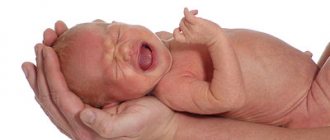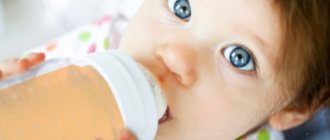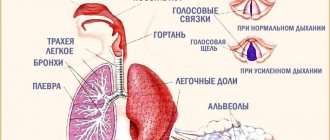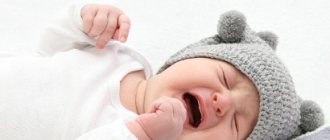Mothers of newborn children are constantly overcome by fears. Every five minutes they run up to the crib to listen to the breathing of the sleeping baby. A common question that young parents ask pediatricians is why does an infant breathe very often during sleep and is this normal? Before you panic, you need to understand the physiological characteristics of babies. This knowledge will help you not worry out of nowhere and understand when something is really wrong with your baby.
Respiratory system of infants
After birth, babies have to independently adapt to new living conditions. Their respiratory system is not yet fully formed, which is why various interruptions and rhythm disturbances may occur.
Features of the respiratory system in newborns:
- small size of the upper and lower respiratory tract;
- narrowness of the nasal passages and passages located in the nasopharynx;
- narrow opening in the larynx area.
These factors affect the normal functioning of the respiratory system.
House dust, plant pollen or animal hair settles on the walls of the mucous membranes and leads to the development of swelling, hyperactivity of the respiratory system or other dysfunctions.
Specifics of newborn breathing
Natural birth is a very difficult, but in many ways a necessary exam for a new person. As it passes through the birth canal, it experiences hypoxia, little oxygen enters the body, and a lot of carbon dioxide is produced. But in response to the accumulation of carbon dioxide, the respiratory center located in the brain, which is about to begin full-fledged work, is irritated.
The fetal lungs are airless and filled with a special fetal, or pulmonary, fluid produced by the cells of the respiratory epithelium. A full-term baby has about 90-100 ml. When a baby is born, it experiences a lot of pressure. His chest is also compressed, and pulmonary fluid is forced out of the respiratory tract.
Partially it is absorbed into the blood, the walls of the lungs, lymph vessels, partially exits through the nose and mouth, and the baby is born with a minimal amount of it. Stress hormones, catecholamines adrenaline and norepinephrine, which are released in the child’s body during his birth, also “wake up” the respiratory center.
The newborn has not yet had time to recover from the “test of birth” - and immediately a large number of external factors begin to act on him: gravity, temperature, tactile and sound stimuli. But all these moments together lead to the baby taking his first breath and then letting out a cry.
Peculiarities of baby's breathing
If a newborn breathes frequently during sleep, but there are no clinical manifestations, the process is normal and is caused by the immaturity of the respiratory system. Rapid breathing in a child during sleep is one of the forms of compensatory processes.
Abdominal breathing is typical for newborns. When inhaling and exhaling, the baby's abdominal muscles actively work. However, over time, children switch to the breast type.
Often the child's breathing may be uneven and intermittent, with short pauses of up to 10 seconds. The condition is normal in newborns and is classified as periodic breathing.
Due to an undeveloped respiratory system, infants can only breathe through the nose. If there is mucus in the nasal sinuses, breathing becomes noisy, the child begins to grunt or wheeze.
In case of complex disorders caused by the accumulation of mucus in the nasal passages, the baby’s breathing will not only be intermittent, but will also begin to be accompanied by sneezing. The process is not pathological and is a natural regulation mechanism.
WHAT PARENTS NOT TO DO
If a baby has breathing problems, parents should not:
|
|
|
|
|
|
What is considered normal breathing for a baby during night sleep?
The presence of violations can be determined by the corresponding signs. The breathing of babies in infancy will differ from the frequency of rhythms in adults.
The first thing you need to pay attention to is the rhythms. The breathing rate in children is much higher and ranges from 40 to 60 times per minute - this is how a newborn child should breathe correctly. However, during sleep, the number of breaths is reduced to 30-40 times. At higher rates, we can talk about the development of tachypnea.
Breathing frequency and types
First inhalation and exhalation
But what is it like - the first breath of a newborn? Very deep. And exhalation is difficult, slow, under pressure, through a spasmodic glottis. These specific respiratory movements, in medical terms, are carried out according to the “gasp” type and continue for about the first 30 minutes of extrauterine existence.
Take a deep breath - the lungs expand, slowly exhale - they do not collapse. However, the first portions of air fill only those corners of the lungs that were completely freed of fetal fluid during childbirth. But then the air quickly rushes into them and straightens them.
Breathing rate
The breathing rate of a newborn in the first few hours of life, the first day, or less often two days, is very high and can be more than 60 respiratory movements (one movement - inhale-exhale) per minute.
Such breathing patterns are called transient hyperventilation. That is, transitional, natural, necessary to adapt to extrauterine existence, such that every minute the child passes a larger volume of air through his lungs than he will do in the future.
Such a high breathing rate is necessary for a newborn to remove the harmful carbon dioxide accumulated in it during birth from the body as quickly as possible. This takes most children no more than a few hours. After which the frequency slows down, already amounting to 40-46 respiratory movements (in an adult, 18-19 are normal).
The baby must breathe intensively also because his breathing is shallow, while his metabolism is much faster than that of an adult, which means the need for oxygen is higher. The deficit in breathing depth is thus compensated by an increase in its frequency.
Why do babies breathe faster when they sleep?
The most common causes of pathology are problems and diseases of the respiratory organs themselves.
Possible reasons:
- Colds, flu, ARVI. The baby's rapid breathing is accompanied by additional signs characteristic of respiratory diseases (cough, runny nose, fever).
- Presence of foreign objects. The pathology is characterized by the presence of extraneous sounds, noises, wheezing, whistling during inhalation/exhalation. The process is accompanied by swelling in the mucous membranes. The newborn breathes heavily in his sleep, begins to choke and wheeze. The condition requires immediate attention to a specialist.
- Cardiovascular disorders. Due to disruptions in the functioning of the cardiovascular system, swelling forms, the area around the eyes and lips becomes blue. At the first sign of violations, you must call an ambulance.
- Infectious and inflammatory processes in the bronchi. Bronchial diseases can be identified by the following signs: loss of appetite, increased irritability or excitability, high body temperature.
- Diseases of the ENT organs. The most common is rhinitis. The newborn's breathing is intermittent during sleep, the mouth is open. Due to the lack of a nose reflex, parents must themselves monitor the baby’s hygiene and clear the nasal passages of mucus.
- Tonsillitis. The pathology is accompanied by grimaces, a constantly open mouth and a drooping jaw. Snoring during sleep is added to the main symptoms. The process can lead to serious disorders, so it is necessary to consult a doctor in a timely manner.
- Apnea. The condition is the most dangerous consequence of tachypnea for the health of an infant. The pathology is characterized by cessation of breathing for more than 10 seconds. After the rhythms resume, breathing becomes heavy and intermittent.
Any manifestations of rapid breathing in combination with other symptoms require immediate contact with a pediatric specialist for diagnosis and appropriate treatment.
Reason 2: Runny nose
Acute shortness of breath with difficulty breathing in a previously healthy baby is most often caused by a runny nose , which in a newborn can be far from a harmless disease and cause difficulty and even stopping breathing.
Treatment of a runny nose
Having cleared the nasal passages from crusts with a tightly twisted cotton wool bandage soaked in warm water, no deeper than 1 cm (there is a separate flagellum under each nostril), a few drops (3 - 4) of hydrogen peroxide solution (1 teaspoon of 2% peroxide solution) are instilled into the nose hydrogen per 2 - 3 teaspoons of water) or boric acid solution (1 teaspoon of dry boric acid per glass of water), or special drops. Children under one year old should not use menthol drops intended for adults. Usually the doctor prescribes a 1% solution of protargol or a 1-2% solution of ephedrine. You should not use a solution of penicillin or streptomycin to treat a runny nose, since excessively frequent use of these drugs can contribute to the appearance of thrush and hypersensitivity.
How to determine if there is a problem
Parents are encouraged to listen to the baby's breathing rhythms during nighttime sleep. Note the appearance of symptoms such as:
- change in the nature and color of the skin (blue or pale skin, especially in the lips or eyes);
- presence of snoring;
- restlessness during sleep (the child cannot sleep peacefully, shudders, tosses and turns, whines);
- increased sweating (hyperhidrosis);
- breathing through the mouth (including while awake);
- enuresis, other disorders of the central nervous system;
- frequent attacks of shortness of breath.
If these symptoms occur, it is recommended to consult a doctor to determine the cause of the disorder and prescribe an effective treatment regimen.
Problems with breathing rhythm disturbances in infants are often observed. However, in most cases, the disorder is not associated with a specific disease and develops against the background of adaptation and formation of the child’s respiratory system. To identify the cause of the disorder, it is necessary to analyze the breathing rhythms of the newborn and pay attention to other symptoms. If you have any suspicions, it is recommended to consult a specialist.
How to help your child breathe properly
Difficulty breathing and disruption of its rhythm can cause colds, improper speech development, and lead to serious health problems. Parents can help their baby normalize breathing and make it more complete. To do this you need to pay attention:
- massage and gymnastics;
- proper clothing;
- temperature and humidity in the room;
- baby's sleeping position.
USEFUL INFORMATION: A child grinds his teeth in his sleep: what does this mean and what to do?
Let's look at these points in more detail.
Massage and gymnastics
General massage has a positive effect not only on breathing, but also on the immune system, lymphatic system, and muscle tone. The easiest way to learn how to do gymnastics correctly is by watching a video and watching an experienced massage therapist.
The right clothes
The respiratory rate is influenced not only by physiological processes, but also by external factors. When putting on pajamas for your child, you need to make sure that they are comfortable for the baby, do not hinder his movements, and the collar is free. It is advisable to choose only natural fabrics. It's best to put on new pajamas for the first time during the day so you can watch your baby sleep.
Temperature and humidity conditions
It is necessary to monitor the temperature and humidity in the room. Snorting while sleeping at night indicates dry air in the room. Comfortable temperature for both newborns and older children is from 18 to 22 degrees, air humidity is from 50 to 60%. In such conditions, the nasal mucosa will not dry out and the child will breathe freely.
When the air is dry, the baby begins to sniffle, and viruses accumulate in the nose. The result is a runny nose, difficulty breathing, lack of oxygen and poor sleep at night. An air humidifier or wet towels placed on radiators will help.
In the cold season, you need to ventilate the room twice a day, and in the summer leave the window open around the clock for good air circulation.
Baby's sleeping position
Pay special attention to your baby's crib: the mattress should be hard, a pillow is not needed at all until one is a year old.
In the first months, a newborn should sleep only on his side. If he turns over on his stomach, he needs to be returned to his previous position, since he cannot yet consciously turn his head during sleep so as not to suffocate. The child rests his nose on the mattress, begins to snore, and the frequency and rhythm of breathing are disrupted due to lack of oxygen. A positioner cushion or a towel cushion placed under the backrest will help you maintain the correct position.
USEFUL INFORMATION: Sleepiness during early pregnancy
If the baby is sleeping and breathing frequently, there is no need to panic ahead of time. It is worth observing his behavior and state of health, and if in doubt, contact your pediatrician for advice.
Reason 5: Child's anxiety
If the child is restless, you need to wrap him in a warm blanket (as for a walk) and go to an open window or go outside. If a child falls asleep quietly on the street, you can stay with him in the fresh air for a long time (30 - 40 minutes), but you need to hold the child not in a stroller, but in your arms in an elevated position. Before the doctor arrives, you can put drops in your nose and make a mustard wrap . There is no need to give any medications. If a child develops bloating, a gas tube or an enema should be placed.
Symptoms
In acute respiratory diseases, rapid breathing is accompanied by hoarseness, runny nose, the temperature rises to low-grade, the newborn is weak and lethargic. Later a cough appears and the voice becomes hoarse. An untreated cold can develop into bronchitis or pneumonia.
- A harbinger of an asthma attack is increased breathing during sleep.
- Rhinitis, which appears without other cold symptoms, may be an allergic reaction, in severe cases with the addition of an asthmatic component. At the same time, the baby begins to sigh frequently and strangely; he lacks oxygen.
- The main sign of bronchitis is a cough; when the disease is chronic, it is persistent (up to 2 months), with copious sputum after waking up. The child is breathing loudly and heavily.
- Pneumonia is dangerous for newborns because its symptoms are not clearly expressed: the temperature rises slightly, the child coughs, breathes unevenly, and has difficulty breathing.
- With tuberculosis, the newborn is weakened, the temperature may not rise or rise slightly. Noisy breathing is accompanied by constant coughing.
- Cardiovascular diseases are characterized by rapid breathing during sleep, and the newborn suffers from shortness of breath. In severe cases, a so-called cardiac cough develops; lips, nails, and wings of the nose become bluish.
If a child has a hysterical attack or a stress reaction, breathing becomes rapid, uneven, may freeze, and be accompanied by strange sounds.
Reason 4: Pneumonia
Difficulty breathing can occur with pneumonia , which requires early medical attention and hospitalization of the newborn child. The mother should be aware of the first signs of this disease. It begins unnoticed: in the first hours there may be no fever or cough. But the child’s general condition worsens. He turns pale, foamy discharge sometimes appears at the corners of the mouth, the nostrils flare wide, the nasolabial triangle turns blue, especially when sucking and screaming. Breathing quickens at first a little, then more and more. In premature babies, general bluishness of the skin and shortness of breath increase especially quickly. The child refuses to breastfeed and becomes restless from oxygen deprivation.
Treatment of pneumonia
Before the doctor arrives, the mother does what needs to be done even if there is an increase in temperature of unknown origin. Under no circumstances should you wrap your baby's chest tightly. He should be able to move his arms and thereby help himself breathe. Frequent drinking from a spoon reduces dry mouth and lips.







